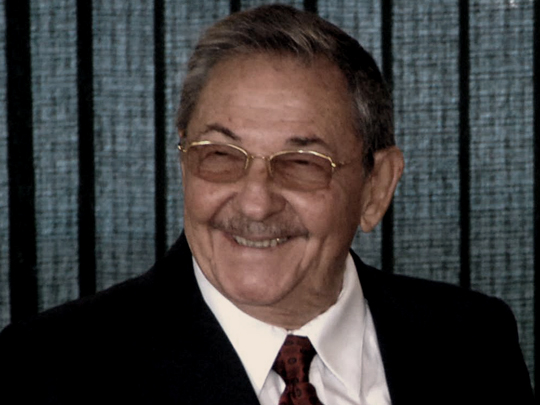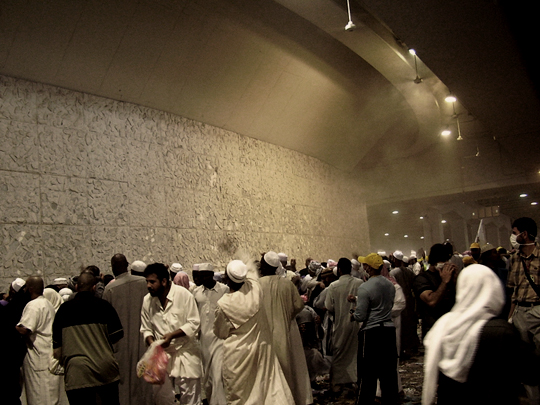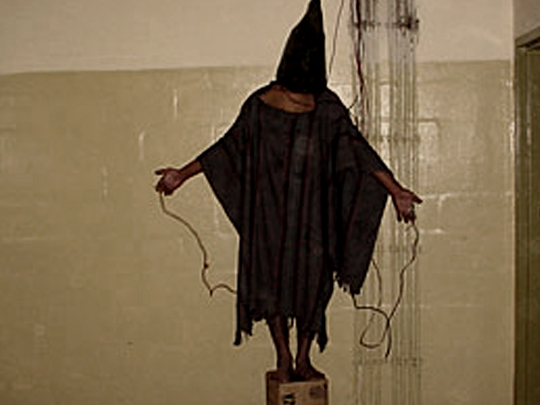US Government / Wikimedia Commons / CC-BY-SA-3.0 / GFDL
1 – The Last of the Abu Ghraib Torture photos are released
During the war in Iraq that began in March 2003, U.S. Army and CIA personnel committed a series of human rights violations against detainees in the Abu Ghraib prison in Iraq, including torture, rape, and murder.
The abuses came to widespread public attention with the publication of photographs of the abuse by CBS News in April 2004.
The administration of George W. Bush asserted that these were isolated incidents, which was disputed by humanitarian organizations.
These organizations stated the abuses at Abu Ghraib were not isolated incidents but part of a wider pattern of torture and ill-treatment in overseas U.S. detention centers, in places such as Iraq, Afghanistan, and Guantanamo Bay.
The United States Department of Defense removed seventeen soldiers and officers from duty. Eleven soldiers were charged with a number of offenses, convicted and sentenced to military prison, and dishonorably discharged from service.
Documents came to light a few years later showing the U.S. Department of Justice authorized certain enhanced interrogation techniques, generally held to involve the torture of foreign detainees.
They argued international humanitarian laws, such as the Geneva Conventions, did not apply to American interrogators overseas.
Many of the torture techniques used were developed at Guantánamo detention center, including prolonged isolation, and a sleep deprivation program which prevented prisoners from sleeping for days, weeks, or even months.
In February 2006, previously unreleased photos and videos were broadcast by an Australian television network. The Bush administration attempted to prevent the release of the images in the U.S.
The new photographs depicted prisoners crawling on the floor naked, being forced to perform sexual acts, and being covered in feces.
They also showed prisoners killed by the soldiers, some after being shot in the head and others with their throats slit.
On 15 March 2006, Salon published extensive documentation of the abuse.
The report included 1,325 images and 93 videos of suspected detainee abuse, 660 images of adult pornography, and 546 images of suspected dead Iraqi detainees.
2 – Cuban President Fidel Castro Transfers Power to His Younger Brother Raul

On 31 July 2006, Fidel Castro’s personal secretary, Carlos Valenciaga, announced on state-run television that Fidel would provisionally hand over the duties of Party Leader, Head of state, and Prime Minister to Raúl Castro, while Fidel recovered from surgery.
Prior to being appointed acting President of Cuba in July 2006, Raul had served as the commander-in-chief of the Armed Forces from 1959 to 2008. His ministerial tenure made him the longest-serving minister of the armed forces.
Raul Castro was officially made President by the National Assembly on 24 February 2008, after Fidel Castro, who was still ailing, announced on 19 February 2008 that he would not stand for President again.
On 17 December 2014, Castro and U.S. President Obama made separate announcements that efforts to normalize relations between the two nations would begin with the re-establishment of embassies in Havana and Washington, which had been closed since 1961.
Cuba and the United States officially resumed full diplomatic relations in July 2015, culminating in President Obama visiting Castro in Cuba on 20 March 2016. It was the first visit of a sitting U.S. president to Cuba in 88 years.
On 21 December 2017, Raul announced on state television that he would step down as Cuban president on 19 April 2018 after his successor is elected by the National Assembly following parliamentary elections.
3 – The Pasta de Conchos Mine Disaster
The Pasta de Conchos mine disaster occurred on 19 February 2006, after a methane explosion in a coal mine near Nueva Rosita, in the Mexican state of Coahuila. The mines were run by Grupo México, the largest mining company in the country.
It was estimated that 65 miners, who had been working the 10 p.m. to 6 a.m. shift that morning, were trapped underground by the explosion. There have been conflicting reports regarding the depth at which the miners were trapped.
The National Mining and Metal Workers Union stated that the trapped miners were about 1,600 feet underground, while Grupo México stated they were about 500 feet below ground.
Each miner was allotted an oxygen pack, but the pack only guaranteed the miners six hours of oxygen.
The Governor of Coahuila also stated the mine’s ventilation service, which used fans to import oxygen and export dangerous gases, was still in operation.
The mine’s workers had previously gone on strike against Grupo México numerous times over concerns about health and safety measures.
On 24 February 2006, Grupo México had advanced halfway into the 1.75-mile long mine, where approx. twenty-four miners were expected to be located.
However, nobody was found. Grupo México suggested the miners were either buried under debris or had been situated in a deeper part of the mine.
Grupo México announced search efforts were to be suspended for two or three days, due to the high levels of natural gas at that depth in the mine.
The following day it was announced the mine would be closed indefinitely once all the bodies were recovered. Only 2 of the 65 bodies have been recovered.
As of August 2016, the Mexican government had still not conducted a thorough investigation into the real causes of the disaster, brought those responsible to justice, recovered the bodies, or compensated the families of the victims.
4 – Stampede During the Last Day at the Hajj Kills Over 345 Muslim Pilgrims

The 2006 Hajj stampede resulted in the deaths of at least 345 people and over 1,000 injured on the final day of a symbolic stoning ritual at the hajj pilgrimage to Mecca.
It happened as tens of thousands of pilgrims filed past al-Jamarat, three large stone walls representing the devil.
The walls are pelted with stones by the pilgrims so they can purge themselves of sin.
The stampede is thought to have started when pieces of luggage fell from moving buses and pilgrims apparently tripped over them as they rushed towards the stone walls.
Authorities in Mecca had taken steps to reduce the chances of another stampede, including the issuing of a fatwa extending the permitted hours of the ritual.
The Hajj is an annual pilgrimage in Mecca undertaken by able-bodied Muslims at least once in their lifetime.
It consists of a series of rites including the Stoning of the Devil which takes place in Mina, a district of Mecca.
The stoning ritual is the last major ritual and is often regarded as the most dangerous part of the Hajj, with stampedes also having occurred in the past.
5 – Twitter is Launched

Twitter is an American online news and social networking service which was created in March 2006 by Jack Dorsey, Noah Glass, Biz Stone, and Evan Williams and launched in July of that year.
Twitter rapidly gained worldwide popularity, with it gaining more than 100 million users by 2012.
During the 2016 U.S. presidential election, Twitter was the largest source of breaking news on the day of the election, with 40 million election-related tweets sent by 10:00 p.m. (EST).
Tweets were originally restricted to 140 characters, but on November 7, 2017, this limit was doubled to 280 for all languages except Chinese, Japanese, and Korean.
Twitter, Inc. is based in San Francisco, California, and has more than 25 offices around the world. As of 2018, Twitter had more than 321 million monthly active users.
